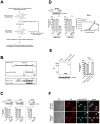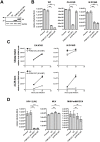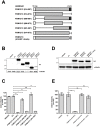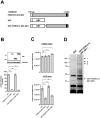N-terminally truncated POM121C inhibits HIV-1 replication
- PMID: 28873410
- PMCID: PMC5584925
- DOI: 10.1371/journal.pone.0182434
N-terminally truncated POM121C inhibits HIV-1 replication
Abstract
Recent studies have identified host cell factors that regulate early stages of HIV-1 infection including viral cDNA synthesis and orientation of the HIV-1 capsid (CA) core toward the nuclear envelope, but it remains unclear how viral DNA is imported through the nuclear pore and guided to the host chromosomal DNA. Here, we demonstrate that N-terminally truncated POM121C, a component of the nuclear pore complex, blocks HIV-1 infection. This truncated protein is predominantly localized in the cytoplasm, does not bind to CA, does not affect viral cDNA synthesis, reduces the formation of 2-LTR and diminished the amount of integrated proviral DNA. Studies with an HIV-1-murine leukemia virus (MLV) chimeric virus carrying the MLV-derived Gag revealed that Gag is a determinant of this inhibition. Intriguingly, mutational studies have revealed that the blockade by N-terminally-truncated POM121C is closely linked to its binding to importin-β/karyopherin subunit beta 1 (KPNB1). These results indicate that N-terminally-truncated POM121C inhibits HIV-1 infection after completion of reverse transcription and before integration, and suggest an important role for KPNB1 in HIV-1 replication.
Conflict of interest statement
Figures







Similar articles
-
The transmembrane nucleoporin Pom121 ensures efficient HIV-1 pre-integration complex nuclear import.Virology. 2018 Aug;521:169-174. doi: 10.1016/j.virol.2018.06.008. Epub 2018 Jun 25. Virology. 2018. PMID: 29957337 Free PMC article.
-
TNPO3 is required for HIV-1 replication after nuclear import but prior to integration and binds the HIV-1 core.J Virol. 2012 May;86(10):5931-6. doi: 10.1128/JVI.00451-12. Epub 2012 Mar 7. J Virol. 2012. PMID: 22398280 Free PMC article.
-
Inhibition of HIV-1 infection by TNPO3 depletion is determined by capsid and detectable after viral cDNA enters the nucleus.Retrovirology. 2011 Dec 6;8:98. doi: 10.1186/1742-4690-8-98. Retrovirology. 2011. PMID: 22145813 Free PMC article.
-
Roles of HIV-1 capsid in viral replication and immune evasion.Virus Res. 2014 Nov 26;193:116-29. doi: 10.1016/j.virusres.2014.07.010. Epub 2014 Jul 16. Virus Res. 2014. PMID: 25036886 Review.
-
The Role of Capsid in the Early Steps of HIV-1 Infection: New Insights into the Core of the Matter.Viruses. 2021 Jun 17;13(6):1161. doi: 10.3390/v13061161. Viruses. 2021. PMID: 34204384 Free PMC article. Review.
Cited by
-
POM121 is identified as a novel prognostic marker of oral squamous cell carcinoma.J Cancer. 2019 Jul 24;10(19):4473-4480. doi: 10.7150/jca.33368. eCollection 2019. J Cancer. 2019. PMID: 31528211 Free PMC article.
-
POM121 is a novel marker for predicting the prognosis of laryngeal cancer.Histol Histopathol. 2020 Nov;35(11):1285-1293. doi: 10.14670/HH-18-267. Epub 2020 Oct 5. Histol Histopathol. 2020. PMID: 33016327
-
Nuclear pore protein POM121 regulates subcellular localization and transcriptional activity of PPARγ.Cell Death Dis. 2024 Jan 4;15(1):7. doi: 10.1038/s41419-023-06371-1. Cell Death Dis. 2024. PMID: 38177114 Free PMC article.
-
FAM13A and POM121C are candidate genes for fasting insulin: functional follow-up analysis of a genome-wide association study.Diabetologia. 2018 May;61(5):1112-1123. doi: 10.1007/s00125-018-4572-8. Epub 2018 Feb 27. Diabetologia. 2018. PMID: 29487953 Free PMC article.
-
The transmembrane nucleoporin Pom121 ensures efficient HIV-1 pre-integration complex nuclear import.Virology. 2018 Aug;521:169-174. doi: 10.1016/j.virol.2018.06.008. Epub 2018 Jun 25. Virology. 2018. PMID: 29957337 Free PMC article.
References
-
- Goff SP. Host factors exploited by retroviruses. Nat Rev Microbiol. 2007;5(4):253–63. Epub 2007/02/28. doi: 10.1038/nrmicro1541 . - DOI - PubMed
-
- Brass AL, Dykxhoorn DM, Benita Y, Yan N, Engelman A, Xavier RJ, et al. Identification of host proteins required for HIV infection through a functional genomic screen. Science. 2008;319(5865):921–6. Epub 2008/01/12. doi: 10.1126/science.1152725 . - DOI - PubMed
-
- Hutten S, Walde S, Spillner C, Hauber J, Kehlenbach RH. The nuclear pore component Nup358 promotes transportin-dependent nuclear import. J Cell Sci. 2009;122(Pt 8):1100–10. Epub 2009/03/21. doi: 10.1242/jcs.040154 . - DOI - PubMed
-
- Woodward CL, Prakobwanakit S, Mosessian S, Chow SA. Integrase interacts with nucleoporin NUP153 to mediate the nuclear import of human immunodeficiency virus type 1. J Virol. 2009;83(13):6522–33. Epub 2009/04/17. doi: 10.1128/JVI.02061-08 ; - DOI - PMC - PubMed
-
- Ciuffi A, Bushman FD. Retroviral DNA integration: HIV and the role of LEDGF/p75. Trends Genet. 2006;22(7):388–95. doi: 10.1016/j.tig.2006.05.006 - DOI - PubMed
MeSH terms
Substances
LinkOut - more resources
Full Text Sources
Other Literature Sources
Research Materials

